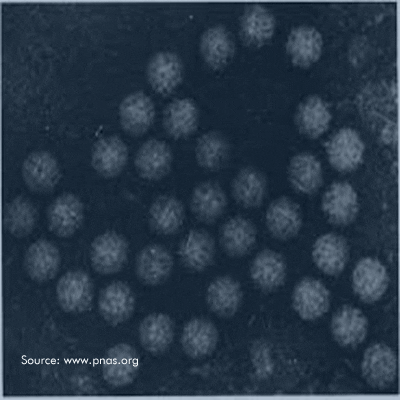
Get A Testing Quote
Echovirus
| Virus | Echovirus |
| Structure | Non-enveloped |
| Family | Picornaviridae |
| Host(s) | Humans |
| Disease(s) Caused | Several manifestations, ranging from mild to life-threatening |
| Symptoms | Skin rashes, upper respiratory distress, sore throat, mouth sores |
| Potential Complications |
Severe neonatal disease, aseptic meningitis, encephalitis myocarditis, pericarditis |
| Transmission Mode |
Fecal-oral, person-to-person contact, water, contaminated fomites |
| Sites of Community Outbreaks | Schools, hospitals, daycare centers |
Importance of Echoviruses
Enteric cytopathic human orphan viruses, known in short as echoviruses, belong to the genus Enterovirus along with the polio- and Coxsackieviruses. Initial viral isolates were extracted from the feces of asymptomatic children in the 1950s, and failed to cause observable disease in suckling mice. Since then, several echovirus strains have been identified as the causative agents of various illnesses including aseptic meningitis, enteritis, and paralysis. Transmission of echoviruses occurs primarily by the fecal-oral route similar to the polioviruses and Coxsackieviruses, although shedding of echoviruses by way of the respiratory tract has also been documented (6). Echovirus infections are generally initiated in the gastrointestinal tract. Following an incubation period ranging from 2 to 7 days, the infection may turn systemic as viruses infect and replicate within peripheral and distal body tissues.
Compared to poliovirus and Coxsackievirus 16 (the latter being the principal causative agent of Hand, Foot and Mouth Disease in the U.S.), echoviruses are rarely highlighted as prominent infectious viral agents of concern to public health. However, echovirus serotypes 13 and 30 have been increasingly implicated in outbreaks of aseptic meningitis in the U.S. and abroad, with person-to-person contact and ingestion of contaminated water identified as the principal transmission routes (5, 7, 8).
The Importance of Disinfection: Survival of Echoviruses on Surfaces and Transmission Potential via Fomites
Echoviruses are non-enveloped in structure, and can remain viable on household objects including glass and cotton fabric for time periods ranging from 2 to more than 12 days, particularly in the presence of organic materials, dust, and coliform bacteria (4). In seawater and freshwater, echoviruses maintain infectivity from several days to upwards of 8 weeks, respectively, with turbidity and suspended solids demonstrated as factors contributing to viability (9). Disinfection of surfaces, in addition to proper water treatment, is therefore of paramount importance when seeking to prevent transmission of echoviruses to potential human hosts. Of six disinfectants evaluated in suspension, only two (0.25% w/v NaOH and 95% v/v ethanol) demonstrated a 6-log10 reduction of echovirus 11 during a 20 second contact time (3). Disinfectant effectiveness against echoviruses has also been demonstrated at the structural level. Glutaraldehyde, a potent virucide, forms high molecular weight complexes with lysine residues on the VP1 and VP3 nucleocapsid proteins of echovirus type 25 at a concentrations of 0.005% (2). Further, the capsid protein of several echovirus serotypes including 4, 5,25, 26, and 29, revealed that the inactivation efficacy of glutaraldehyde (0.10%), was correlated to the number of lysine residues and their distribution on the VP1 nucleocapsid protein (1).
References
- Chambon, M. et al. 2004. Virucidal efficacy of glutaraldehyde against enteroviruses is related to the location of lysine residues in exposed structures of the VP1 capsid protein. Applied and Environmental Microbiology. 70: 1717-1722.
- Chambon, M. et al. 1992. Activity of glutaraldehyde at low concentrations against capsid proteins of poliovirus type 1 and echovirus type 25. Applied and Environmental Microbiology. 58: 3517-3521.
- Drulak, M., A. Wallbank, and I. Lebtag. 1978. The relative effectiveness of commonly used disinfectants in inactivation of echovirus 11. The Journal of Hygiene. 81: 77-87.
- Kiseleva, L. 1968. Survival of enteric viruses in water and foodstuffs and on various surfaces. Hygiene and Sanitation. 33: 439-440.
- Mirand, A. et al. 2007. Emergence of recent echovirus 30 lineages is marked by serial genetic recombination events. Journal of General Virology. 88: 166-176.
- Modlin, J. et al. 1981. Perinatal ECHOvirus infection: risk of transmission during a community outbreak. New England Journal of Medicine. 305: 368-371.
- Mohle-Botani, J. et al. 1999. Viral meningitis in child care center staff and parents: an outbreak of echovirus 30 infections. Public Health Reports. 114: 249-256.
- Mullins, J. et al. 2003. Emergence of echovirus type 13 as a prominent enterovirus. Clinical Infectious Diseases. 38: 70-77.
- Rzezutka, A. and N. Cook. 2004. Survival of human enteric viruses in the environment and food. FEMS Microbiology Reviews. 28: 441-453.
Share

